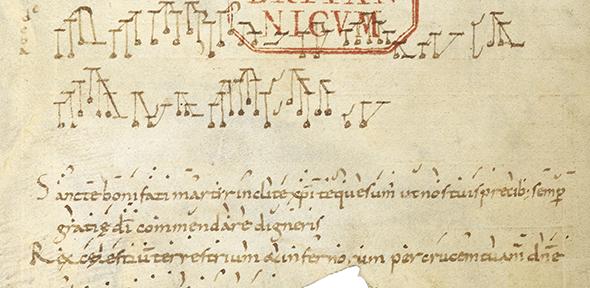
The earliest known practical example of polyphonic music - a piece of choral music written for more than one part - has been found in a British Library manuscript in London.
The inscription is believed to date back to the start of the 10th century and is the setting of a short chant dedicated to Boniface, patron Saint of Germany. It is the earliest practical example of a piece of polyphonic music – the term given to music that combines more than one independent melody – ever discovered.
Written using an early form of notation that predates the invention of the stave, it was inked into the space at the end of a manuscript of the Life of Bishop Maternianus of Reims.
The piece was discovered by Giovanni Varelli, a PhD student from St John’s College, University of Cambridge, while he was working on an internship at the British Library. He discovered the manuscript by chance, and was struck by the unusual form of the notation. Varelli specialises in early musical notation, and realised that it consisted of two vocal parts, each complementing the other.
Polyphony defined most European music up until the 20th century, but it is not clear exactly when it emerged. Treatises which lay out the theoretical basis for music with two independent vocal parts survive from the early Middle Ages, but until now the earliest known examples of a practical piece written specifically for more than one voice came from a collection known as The Winchester Troper, which dates back to the year 1000.
Varelli’s research suggests that the author of the newly-found piece – a short “antiphon” with a second voice providing a vocal accompaniment – was writing around the year 900.
As well as its age, the piece is also significant because it deviates from the convention laid out in treatises at the time. This suggests that even at this embryonic stage, composers were experimenting with form and breaking the rules of polyphony almost at the same time as they were being written.
“What’s interesting here is that we are looking at the birth of polyphonic music and we are not seeing what we expected,” Varelli said.
“Typically, polyphonic music is seen as having developed from a set of fixed rules and almost mechanical practice. This changes how we understand that development precisely because whoever wrote it was breaking those rules. It shows that music at this time was in a state of flux and development, the conventions were less rules to be followed, than a starting point from which one might explore new compositional paths.”
The piece is technically known as an “organum”, an early type of polyphonic music based on plainsong, in which an accompaniment was sung above or below the melody.

The fact that it was an early example of music for two parts had probably gone unnoticed because the author used a very early form of musical notation for the polyphonic piece, which would have been indecipherable to most modern readers. “When I tried to work out the melody I realised that the music written above was the same as the one outlined by the notation used for the chant and that this sort of 'diagram' was therefore a two-voice piece based on the antiphon for St Boniface”, Varelli said. “The chant notation essentially gives the direction of the melody and when it goes up or down, the organum notation consistently agreed, giving us also the exact intervals for the chant.”
Who wrote the music, and which monastic house it came from, remains a mystery, but through meticulous detective work Varelli has been able to pin its likely origins down to one of a number of ecclesiastical centres in what is now north-west Germany, somewhere around Paderborn or Düsseldorf.
This is partly because the type of plainchant notation – sometimes known as Eastern Palaeofrankish – was most used in Germany at that time. In addition, however, an unknown scribe had added a Latin inscription at the top of the page which when translated reads: “which is celebrated on December 1”.
This odd comment, a reference to the Saint’s Day for Maternianus, alludes to the fact that unlike most monastic houses, which celebrated Maternianus on April 30, a handful of communities in north-western Germany did so on December 1. Combined with the notation itself, this makes it likely that whoever wrote the music was based in that region.
“The music was added some time after the main saint’s life was written,” Varelli added. “The main text was written at the beginning of the 10th century, and on this basis, we can conservatively estimate that this addition was made some time in the very first decades of the same century”.
“The rules being applied here laid the foundations for those that developed and governed the majority of western music history for the next thousand years. This discovery shows how they were evolving, and how they existed in a constant state of transformation, around the year 900.”
Nicolas Bell, music curator at the British Library, said "This is an exciting discovery. When this manuscript was first catalogued in the eighteenth century, nobody was able to understand these unusual symbols. We are delighted that Giovanni Varelli has been able to decipher them and understand their importance to the history of music."
The video shows the piece being performed by Quintin Beer (left) and John Clapham (right), both music undergraduates at St John’s College, University of Cambridge.
New research has uncovered the earliest known practical piece of polyphonic music, an example of the principles that laid the foundations of European musical tradition.
The text in this work is licensed under a Creative Commons Licence. If you use this content on your site please link back to this page. For image rights, please see the credits associated with each individual image.
